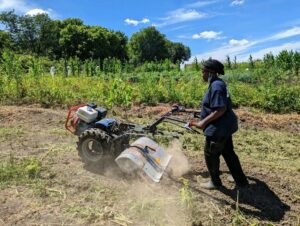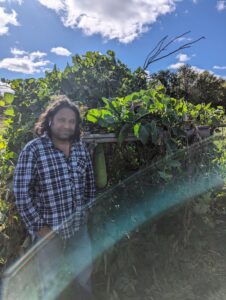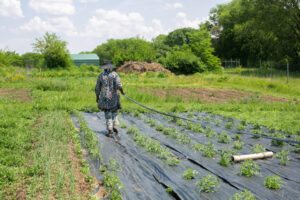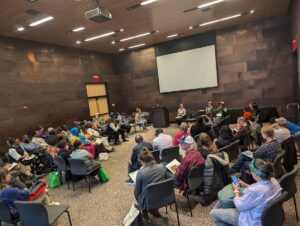Project Overview
Information Products
Commodities
Practices
- Crop Production: cover crops, irrigation, organic fertilizers, water management
- Education and Training: demonstration, farmer to farmer, mentoring, networking, technical assistance, workshop
- Farm Business Management: land access, new enterprise development
- Natural Resources/Environment: conservation practices on small specialty crop farms
- Pest Management: integrated pest management, mulches - general, weed ecology
- Production Systems: organic agriculture
- Soil Management: composting, soil quality/health
- Sustainable Communities: analysis of personal/family life, ethnic differences/cultural and demographic change, leadership development, local and regional food systems, partnerships, quality of life, social capital, social networks, urban agriculture
Abstract:
- An explanation of the problem addressed and the solution pursued
Climate variability and land access issues make adoption of sustainable agriculture practices and multi-stakeholder collaboration increasingly important. This is especially true for refugee and immigrant (R&I) farmers who face barriers related to language and supportive networks. At the start of this project, LSI has successfully graduated seven farmers from its incubator program and had a new cohort of farmers ready to move onto their own land. It had established relationships with other regional farms for R&Is to serve as a forum for sharing culturally relevant training material, establishing peer farmer mentorship and addressing common issues among farms serving R&Is. With a proven path to success for farmers in its program, Global Greens (GG) implemented the “Communities of Practice and Farmer Led Training for Increased Sustainability of Refugee & Immigrant Farms in the North Central Region” program with the following objectives: 1) Offer continued learning opportunities for R&I farmers on sustainable practices, both virtually and in person, to increase long-term soil health and profitability. 2) Establish a Community of Practice among regional initiatives working with R&Is to enhance shared goals, find solutions to pressing issues and provide cross learning opportunities among regional farmers. 3) Incorporate mentorship between graduate and beginning farmers to improve adoption of sustainable practices that will prepare them for successful management of their own farm. The approach includes: Partnership with Iowa State University Extension and other research institutions to identify existing research on crop cover and simple water conservation techniques that can be replicated in-field and set up demonstrations on the training farm and graduate farmer plots for experiential learning. Regular in-field workshops or monthly visits to observe and discuss the work, and to record and discuss results. Events and handouts would be recorded or published to share with the wider networks. A field day event will be held to showcase the end of project results. The work would also result in increased availability of appropriate education materials and information sharing through a strengthened regional community of practice that meets regularly and encourages mentorship between graduate and beginning farmers through resources and tools. The project not only enhanced opportunities for LSI’s GG program and the next cohort of farmers, but also allowed for learning between the GG program, other regional programs, and participants in those programs to build environmental and economic sustainability.
2. The project's research approach (if conducted), educational approach and farmer learning outcomes.
Research and Education Approach: From the first year and annually, LSI consulted with experts at Rodale, Iowa State University, and Practical Farmers of Iowa to gather technical information and best practices used by small scale horticulture farmers in the Midwest. We used that information to distill what we would be able to do to set up field plots with farmers given language and cultural barriers. The best mix of cover crops and other soil practices was identified. From this it was determined that rather than separate demonstration plots, the program would also implement a“try and see” approach encouraging farmers to try out cover crops on their own plots, providing support with inputs, so they could learn the efficacy of cover crops to increase soil fertility in a short period of time, and then share and report to LSI and each other which ones worked best in which season and the results they observed on their crops and soil health.
In field meetings, discussions and workshops were held throughout the season to gather feedback and observe results together and adapt as needed. Training handouts and related materials for learning on cover crops from this were created and are shared with this report. These materials were developed and shared with the regional Community of Practice and shared with other farm programs as well (over 5).
Learning Outcomes: From the first year in the early spring and in subsequent years, LSI conducted classes with farmers on this initial information and project goals, and requested feedback on challenges on their operations and asked for feedback on the reasons they were not currently using cover crops. Answers were related to availability, lack of knowledge on which cover crops serve which functions, how to plant, and how to terminate. More advanced questions highlighted the issue that this grant was intended to solve--namely that farmers have small plots that they rent and they need to make money from and were not sure what the economic benefits would be from these practices. With that in mind, farmers also mentioned that they have had problems with germination and yield in areas they have used for more than 2 years and showed a willingness to try new practices to address this. This dialogue was important in building trust, identifying barriers and solutions, and establishing expectations for the project. That first year we intensively worked with 5 farmers to add cover crops into their planting plans. Through this, we found that farmers wanted “recipes” for cover crops that help them decide what they want with lots of details and instructions. This feedback and the technical information set the foundation for the two page sheet we developed called “cover crops on small plots” and small booklet and presentations we used in cover crop classes outside the season. We are now able to pull slides from these materials to use in our yearly “Organic 101” class. Throughout the project we found the 2 page sheet to be the most popular. The first year, we also identified that graduates may have more challenges implementing the practices, as over the 3 years of the project we have had the most farmers graduate than any other time due to new land partnerships. While this was great to scale their operations, farmer time was spent on securing farms and building infrastructure and they did not have as much time to share demonstrations with other farmers on their land. For this reason, we pivoted to focus more on incubator farmers implementing the demonstrations on their own plots at the incubator farm, rather than focusing on graduates and implemented “Cover Crop swap” in the fall, which offered additional land size to farmers that participated in the cover crop demonstrations. In this option, farmers can trade beds, or let their assigned plot fallow and be cover cropped, and are given another plot to use in the meantime that had cover crops on it already so they could realize the benefit more quickly, and then go back to their old plot once ready to see the difference. This allowed them to not lose any production space AND implement cover crops which was incredibly useful and impactful. In addition, with more graduate land sites identified, and farmers moving to these sites from the incubator site more frequently, it makes sense to have farmers start these practices and become accustomed to them to ensure they are carried forward to their first years on new and larger land.
3. Succinct statement of research conclusions
Though this project was education focused rather than research focused, the results of the outreach and education, is that farmers saw a significant impact as a result of adopting the cover crop practices, in particular, as many had farmed the same plot for several years, and so immediately so the increase in yields as a result of changing to the plot that had been covered plot, and then returning to the same plot they had cover cropped in the meantime. Introduction of water conservation methods at the incubator farm, such as drip tape, also resulted in adoption when farmers moved to larger land off site of 1 to 5 acres, as well as the desire to continue with the cover crop practices they had experimented with at the incubator. To date, 15 of the 29 farmers actively use more than one of the practices from this program and all 29 have adopted at least one and have begun to use these practices independently, including cover crop, drip tape and straw mulching, on their own going forward.
4. Farmer adoption actions that resulted from the education program.
One particular success was an advanced farmer at the Johnston site in the first year who made a cover crop and water management plan, procured supplies, and installed oats and peas in the early spring with great results. She described how she had the best year ever for pumpkins because of the spring cover crop she planted which improved the soil quality and germination. She shared that experience a few times in different teaching settings and farm tour groups to over 120 people. This success led to the adoption of cover crops from other incubator farmers in subsequent years.
We identified 5 more farmers as “Cover Crop Ambassadors” in the second year of the project at the Global Greens Incubator Farm and we spent more time meeting 1-1 with them about soil health goals. After an initial cover crop and soil health class in March (as done each year), these farm leaders have been instrumental in identifying and implementing best practices that work for small scale farmers. Other farmers at the incubator farm have observed, learned from and replicated these strategies. The introduced cover crops specifically included spring planting of oats and peas followed by crops like winter squash; mid-season plantings of buckwheat following a short spring crop and bookended by a late season planting of lettuce, radish, etc.; and a rye/vetch mix planted in the fall that comes back the next spring which we can strip till or fully terminate for transplants of tomatoes or eggplants. We continued to use the simple two-sided handout that shares these farmer-identified practices that are used at field days and in class. Through these three strategies we offer simple cover crops solutions to small scale market farmers that help them make money and improve soil. That practice serves them well on a small scale and they will NEED to do it for soil health on a larger scale. When we initially started the project, we felt that the small-scale farmers on the incubator farm would be less likely to adopt the practices than graduates farming on a larger scale, as it would be harder to see the benefits and adopt them. However, we are pleased to see that with more focus on the incubator farmers, they were willing to implement cover crops on their smaller plots and they saw soil health benefits. These 5 farmers have become instrumental in co-teaching field days, farm tours, and external presentations. As a result of seeing the impact on the early adopters, all incubator farmers have requested to plant cover crops.
As a result, in the last year of this project saw 15 of the 29 farmer families implementing cover crops and water management practices on their own, an increase from 3 out of 29 at the beginning. Three incubator farmers requested and received hands on help in their ¼ acre plots to set up drip tape in May. Now all 15 farmer graduates are using drip tape and we help them get drip tape and cover crop supplies in bulk. All of these 29 farmers also showed an increased interest in straw mulching, and 15 of them have already implemented a soil health and water conservation strategy together.
Two incubator farmers graduated onto 3 acre plots at a new community farm in Granger, Iowa. Partnered with Practical Farmers of Iowa, and they both requested and received help for cover crop planting and water management. They both took the time their first year on the plots to develop drip tape watering plans as well. They demonstrated their practices at the 2024 field day.
July 21st 2024 was our Cover Crops Field Day at the incubator farm. 2 farmers who had used cover crops in their ¼ acre plots spoke to the attendees about their soil health before and after the cover crops. They also spoke to how and when they were doing the cover crop around their cash crops. Farm Manager Jennie also spoke about how she uses cover crops to hold fallow plots and rest them in between cash crops and how she uses them to fight invasive weeds like Canadian Thistle.
[caption id="attachment_1236727" align="alignnone" width="300"]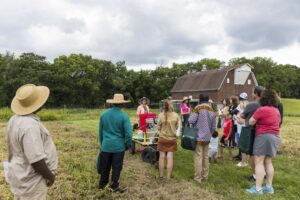 Farmer presenting on use of cover crops and practices.[/caption]
Farmer presenting on use of cover crops and practices.[/caption]
July 22nd 2024 was a day for incubator farmers to explore the new graduate farm site in Granger, and learn from those recent graduates how the transition was going and what skills they were needing most in the first year off incubator.
Story:
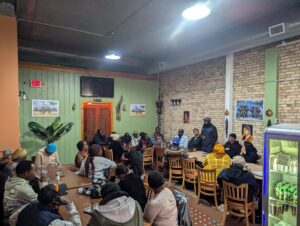 During Conference in Minnesota graduate farmers shared with other immigrant farmer group about practices used.[/caption] [caption id="attachment_1236594" align="alignnone" width="300"]
During Conference in Minnesota graduate farmers shared with other immigrant farmer group about practices used.[/caption] [caption id="attachment_1236594" align="alignnone" width="300"]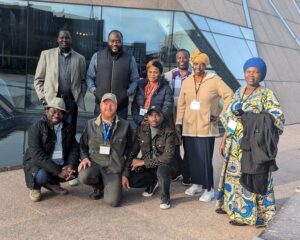 Farmers and staff at 2024 Emerging Farmers Conference[/caption]
Farmers and staff at 2024 Emerging Farmers Conference[/caption]
Project objectives:
Objective 1. Farmer led training on sustainability to improve land for on-going profitability with the goal of 30 farmers using practices that increase production and demonstrate increased knowledge of sustainability practices for greater production.
This was achieved in that 15 Global Greens farmers implemented the all the demonstrated practices and 29 had implemented at least one and had plans to use mulch and several other of the practices in the next season. 32 Global Greens farmers were introduced to cover crops, attended workshops and in field sessions and learned practically about their use and benefits.
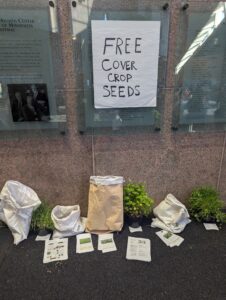
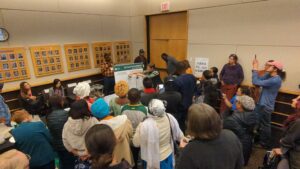
Objective 2. Regional community of practice (COP) that connects R&I farms and farmers including a COP with 5 R&I farms established that increases resources and peer networks among farmers. As a result, resources are shared to strengthen programs that serve R&Is and improve farmer connectivity.
This was achieved in that more than 5 R&I farm programs are strengthened by having access to the resources and practical demonstrations on their use, and 3 R&I regional organizations regularly attended meetings and worked together to create and share materials and address issues facing farmers in the region. By the end of the project, the 3 core COP partners and 5 or more partners in the region are taking part and benefiting from content and other resources and best practices shared by the core COP members.
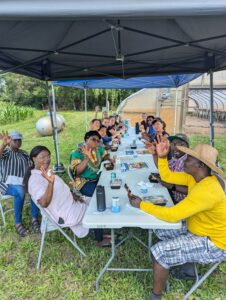
Objective 3. Peer mentorship to accelerate sustainability so that 30 farmers utilize learning from peers resulting in greater achievement of farm goals and increase knowledge of practices listed in their goals.
This objective was achieved in that 30 farmers utilize the learning from peers and program leaders to achieve their farm goals and increase knowledge on the sustainability practices listed in their goals, mostly related to water management and soil health and cover crops.
